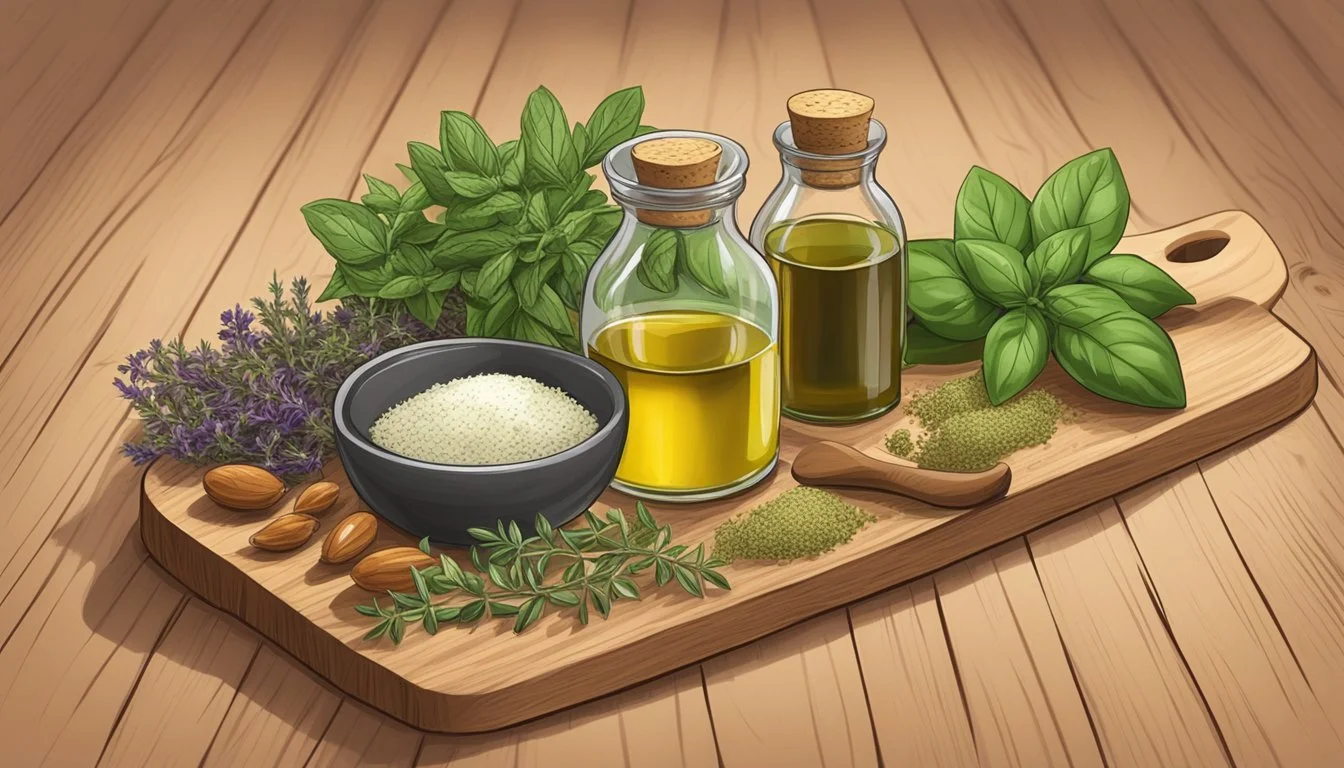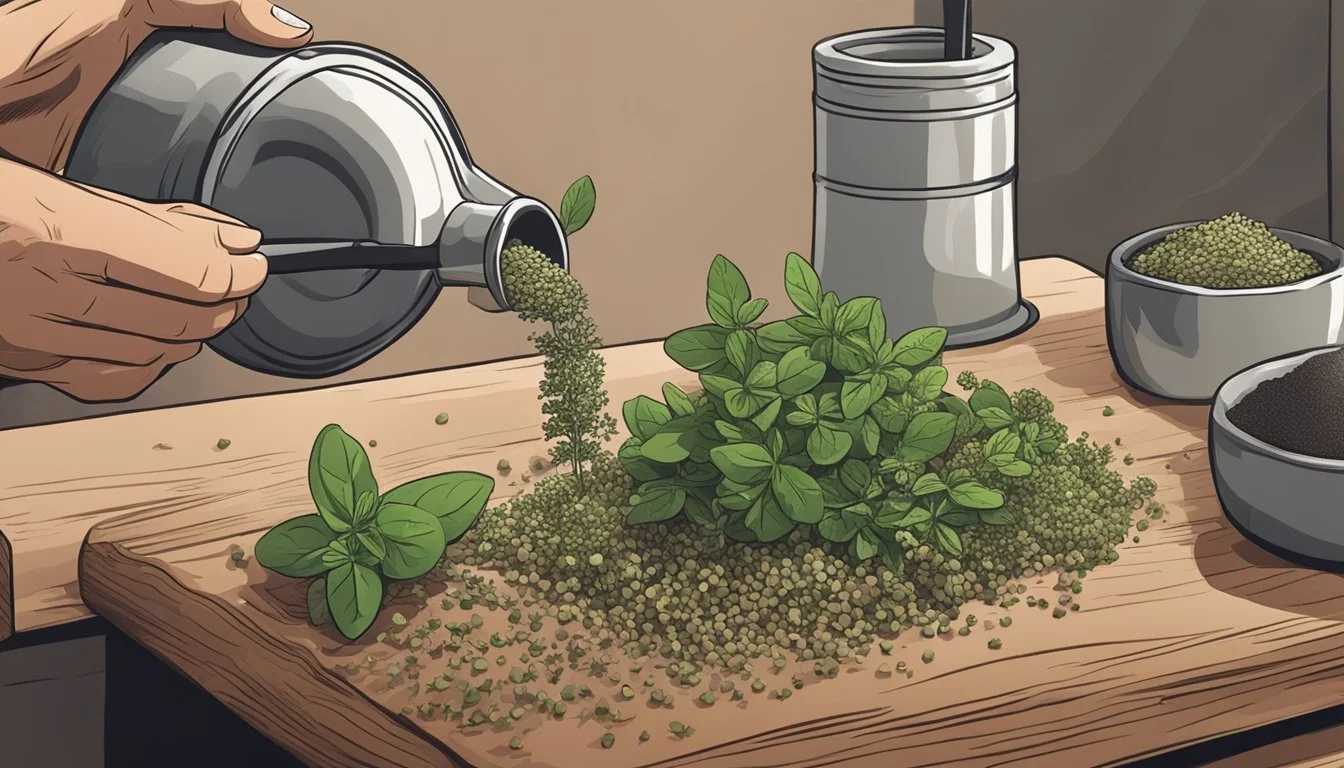Marjoram Substitutes
Top Alternatives for Your Recipes
Marjoram is a versatile herb widely used in Mediterranean cooking, known for its aromatic, sweet, and slightly citrus flavor which complements a variety of dishes. Often used in seasoning soups, sauces, and meat preparations, marjoram's presence is notable for enhancing culinary creations with its unique taste. However, this herb is not always readily available in every kitchen, necessitating the need for substitutes that can mimic or complement its flavor profile in recipes.
When marjoram is not at hand, several other herbs step up as commendable replacements. Oregano, a cousin to marjoram within the mint family, shares a similar flavor but with a stronger, more robust profile. This makes it an excellent substitute that can be used in a pinch. Other herbs like thyme, basil, and summer savory also offer compatible flavors that work well in dishes traditionally calling for marjoram. The key to using these substitutes is to understand their flavor strengths and how they interact with the other ingredients in the recipe.
Using substitutes for marjoram requires an adjustment in quantity and expectations, as each herb imparts its own character to a dish. For those looking to retain the essence of marjoram's taste, a careful balance of these alternative herbs can provide a harmonious flavor akin to the original ingredient. Whether using dried or fresh forms, marjoram's substitutes are valuable components in the seasoned cook's arsenal, ensuring that the essence of Mediterranean cuisine can be achieved even when marjoram is absent.
Understanding Marjoram
Marjoram, a perennial herb with a unique and pleasant aroma, boasts a versatile use in the kitchen and is a staple in Mediterranean cuisine. It belongs to the mint family and has different forms, including sweet marjoram and knotted marjoram, each with its distinct flavor profile.
Botanical Profile
Marjoram (Origanum majorana) is a tender perennial herb in the Lamiaceae family, which is the mint family. It's often confused with oregano, to which it is closely related botanically and often called wild marjoram or pot marjoram in its less cultivated form. The plant is characterized by its small, oval-shaped leaves and small, clustered flowers that are typically white or pale pink.
Culinary Uses
Marjoram plays a significant role in Mediterranean cooking. It is used fresh or dried to season soups, sauces, dressings, and various meat dishes. Its sweet pine and citrus flavors make it especially popular in seasoning sausages, poultry, and lamb. The use of marjoram extends to vegetarian cooking, where it complements the taste of vegetables and legumes.
Flavor Profile
The flavor of marjoram is warm, slightly sharp, and has a hint of balsamic sweetness which distinguishes it from its botanical cousin, oregano. Sweet marjoram, known for its more delicate taste, is preferred for its subtle woodsy, citrus undertones that can enhance dishes without overpowering them. The flavor is best preserved when the leaves are added toward the end of the cooking process.
Popular Marjoram Substitutes
Selecting a substitute for marjoram depends on the specific flavors and aromatic qualities that marjoram would contribute to a dish. Here are three popular herbs that can serve as suitable replacements.
Oregano
Oregano is the closest relative to marjoram, which makes it an excellent marjoram substitute. Both herbs belong to the genus Origanum. In dishes, one can typically use oregano in the same quantity as marjoram. However, oregano has a slightly stronger flavor, so it's advisable to start with equal parts and then adjust to taste.
Ratio: 1:1, adjust as needed
Thyme
Thyme is another versatile herb that can substitute for marjoram, especially in roasts and stews (What wine goes well with stews?) where its robust essence complements hearty flavors. Its milder taste allows for a 1:1 substitution ratio with marjoram, though the flavor profile is different, as thyme brings a more earthy tone to dishes.
Ratio: 1:1, add more if necessary
Basil
Basil offers a sweet and slightly peppery flavor that can work as a marjoram substitute, particularly in Italian cuisine. While basil does not mimic marjoram's taste perfectly, it can add a fragrant, fresh touch to recipes that require marjoram. Modify the amount of basil based on the recipe and desired flavor intensity.
Ratio: Start with less, adjust to preference
These herbs are common staples in spice collections and can often be found in blends such as Italian seasoning and herbes de Provence, which may also serve as substitutes for marjoram in a pinch.
Substitutes by Type of Dish
When looking for a marjoram substitute, it's important to consider the specific dish being prepared. Different herbs can complement or enhance the flavors of various categories of dishes—from meats to vegetables—while maintaining the integrity of the original recipe.
Meat Dishes
For meat dishes, especially those with Mediterranean origins, oregano is an excellent substitute. Its robust flavor complements red meats particularly well. In dishes like Italian Chicken Cacciatore, a 1:1 ratio of fresh oregano can be used in place of marjoram, offering a similar taste profile.
Soups and Stews
In soups and stews, thyme serves as a suitable replacement for marjoram. It imparts a subtle earthiness with hints of mint, which can enhance the comforting nature of these dishes. For a typical American cuisine stew, start with a 1:1 substitution and adjust to taste.
Vegetables
Vegetable dishes often benefit from herbs that add a fresh, aromatic quality. Parsley offers a light, herbaceous essence that doesn’t overpower delicate vegetable flavors. Utilizing parsley as a substitute can elevate grilled vegetables or salad dressings with a clean and fresh note.
Sauces and Dressings
In sauces and dressings, Greek oregano brings a warm and slightly bitter taste that can withstand the cooking process or complement the tanginess of vinaigrettes. For a classic Mediterranean sauce, Greek oregano is often preferred, while a less assertive herb like lemon thyme offers a zestier aroma suitable for lighter dressings.
Other Herb and Spice Substitutes
In addition to oregano and basil, several other herbs can act as substitutes for marjoram in various dishes. These alternatives offer their own unique flavors and can be used to complement the tastes in different recipes.
Sage
Sage is an aromatic herb with earthy and slightly peppery notes. It's a common ingredient in poultry and meat dishes, especially in Italian cuisine. As a substitute for marjoram, use sage sparingly due to its more robust flavor.
Summer Savory
Summer savory, with its peppery and mildly spicy flavor, is a part of the French herbes de provence blend. It's a suitable marjoram substitute in recipes like stews and bean dishes. Replace marjoram with an equal amount of summer savory for a comparable taste.
Tarragon
Tarragon offers a distinctive anise-like sweetness, making it an interesting stand-in for marjoram. It works well in French cuisine and can bring a fresh dimension to sauces and chicken dishes. Use a smaller quantity of tarragon to prevent its flavor from overpowering the dish.
Rosemary
Rosemary, known for its woodsy and lemon-pine flavor, can serve as a marjoram substitute, especially in hearty dishes like roasts and grilled meats. Since rosemary is potent, it's advisable to use less than the amount of marjoram called for—usually about half as much rosemary will suffice.
Creating Custom Spice Blends
When Marjoram is unavailable, one can still capture its essence by experimenting with other herbs in custom spice blends. These mixtures draw from Mediterranean and Middle Eastern culinary traditions, offering a tapestry of flavors that can closely mimic or even surpass the qualities of marjoram in various recipes.
Herbes de Provence
Herbes de Provence is a classic French spice blend that typically includes a mix of dried herbs indicative of the Provence region. To create a substitute for marjoram within this blend, chefs can incorporate the following ingredients:
Thyme: for its earthy and slight mint flavors.
Basil: which adds a sweet and fragrant component.
Rosemary: for a woody, citrus-like depth.
A basic experimental ratio could be:
Herbs Quantity Thyme 1 part Basil 1 part Rosemary 1/2 part
One might add lavender or fennel for an aromatic nuance.
Italian Seasoning
Italian Seasoning is a versatile blend that complements a wide range of dishes with flavors typical of Italian cuisine. For a marjoram-influenced Italian Seasoning, the blend may include:
Oregano: a robust herb that offers a similar taste profile to marjoram.
Basil: for sweetness and a hint of anise.
Rosemary: providing a pungent, earthy note.
A potential blending guideline:
Herbs Quantity Oregano 2 parts Basil 1 part Rosemary 1 part
Such a blend complements tomato-based sauces, poultry, and vegetable dishes.
Za’atar
Za’atar is a Middle Eastern spice mixture that can incorporate marjoram's flavors via its diverse ingredients:
Sumac: for its tangy, lemon-like flavor.
Thyme: as a base herb with a subtle, minty profile.
Sesame Seeds: which add texture and a nutty undertone.
Suggested proportions may include:
Herbs Quantity Sumac 2 parts Thyme 2 parts Sesame Seeds 1 part
Za’atar is often used on flatbreads, meats, and as a seasoning for vegetables.
Factors Influencing Substitution
When replacing marjoram in recipes, cooks must consider the herb’s form, its intensity, and how it pairs with other flavors to ensure a successful substitution.
Fresh vs. Dried Herbs
Fresh marjoram is typically less potent than dried marjoram, due to the reduction of moisture content and concentration of essential oils in the drying process. To substitute dried herbs for fresh, a ratio of 1 teaspoon of dried for each tablespoon of fresh marjoram is recommended. This ratio helps maintain the desired flavor without overpowering a dish.
Intensity and Potency
The potency of a spice or herb is largely governed by the concentration of essential oils, which can vary between fresh and dried versions. Dried marjoram typically has a more concentrated flavor and should be used sparingly if replacing a fresh herb to prevent it from dominating other flavors within the recipe.
Flavor Pairings
Marjoram pairs well with a variety of foods, and its substitutes should complement the same ingredients. Oregano, being closely related to marjoram, mirrors its warm and slightly sweet profile, making it an ideal substitute in Mediterranean dishes. Other herbs like thyme can also be used, but may alter the flavor profile due to their distinct characteristics. When substituting, one must consider the main flavors of the dish to achieve the desired culinary balance.
Health Benefits and Considerations
Marjoram, a herb known for its aromatic leaves, is not only a staple in Mediterranean cuisine but also valued for its health benefits. It is part of the mint family and closely related to oregano. Marjoram can be found fresh or dried and is commonly used in herbal teas and as an essential oil.
Health Benefits:
Digestive Health: Marjoram is used to mitigate digestive disorders. It may aid in soothing stomach upsets and relieving nausea.
Antimicrobial Properties: As an essential oil, marjoram has shown to possess antimicrobial qualities.
Anti-inflammatory: Marjoram may help reduce inflammation and could be beneficial in managing symptoms of arthritis or other inflammatory conditions.
Culinary Considerations when Substituting Marjoram:
Flavor Profile: Marjoram has a sweet, citrusy, and woody flavor. When substituting, consider herbs that share a similar flavor profile.
Potency: Herbs vary in potency; start with a 1:1 substitution ratio and adjust to taste.
Common Substitutes:
Substitute Ratio Notes Oregano 1:1 Closest in flavor; use similarly to marjoram. Thyme 1:1 Milder, but can evoke a similar aromatic quality. Basil 1:1 Adds a sweet and slightly peppery taste.
When using marjoram for its health benefits, it’s important to consider that its efficacy can vary and scientific evidence is not definitive. Always consult with a healthcare provider when using marjoram, especially in essential oil form, for health purposes.
Practical Tips for Substituting Marjoram
When cooking, if one encounters a lack of marjoram, several other herbs can be used as a replacement due to their similar profiles. Oregano is often the first choice because it's closely related to marjoram and shares a similar earthy and woodsy aroma. As both herbs belong to the same genus, Origanum, they exhibit comparable flavor notes.
Substitutes List:
Oregano: The closest match in terms of flavor; use in a 1:1 ratio.
Thyme: Offers an earthy tone, but with a slightly different aroma; it can be a component of a blend.
Basil: Delivers a fresh, sweet note to recipes; best used in dishes where sweetness is desired.
Savory: Brings an earthier profile and goes well with beans and meats.
While substituting, it is important to consider the form of marjoram called for in the recipe; fresh herbs often have a more subtle taste than dried ones. A good rule of thumb for conversion is:
Conversion Table:
Fresh Marjoram Dried Marjoram Conversion 1 tablespoon 1 teaspoon
In addition to these substitutes for marjoram, chefs may experiment with parsleys or lemon thyme to introduce citrusy notes into their dishes, especially in Mediterranean cuisine where marjoram is a versatile herb. Adjust the substituted herbs according to their aroma strength—starting with small amounts and adding more as needed—to ensure a balanced flavor in the dish.






